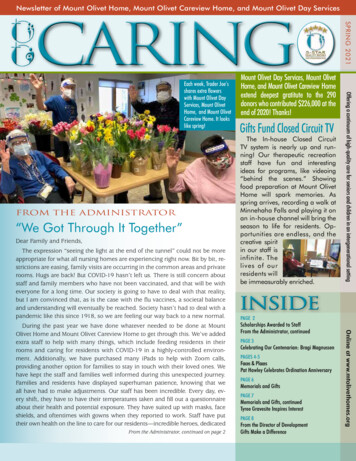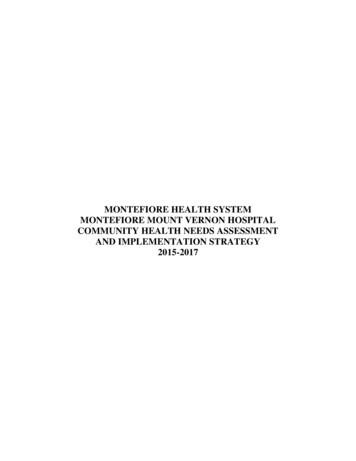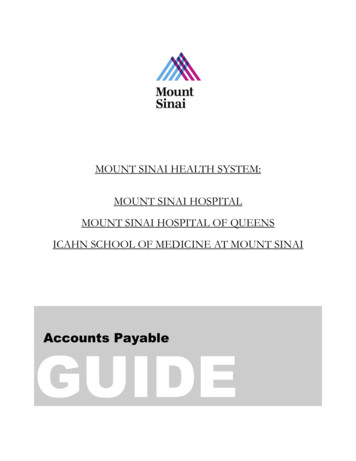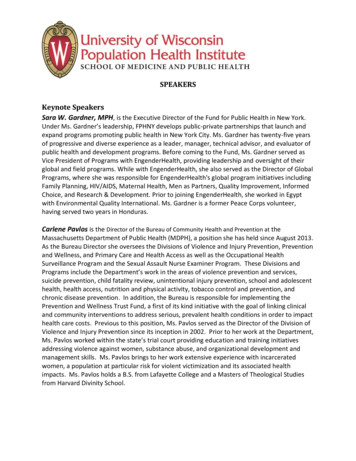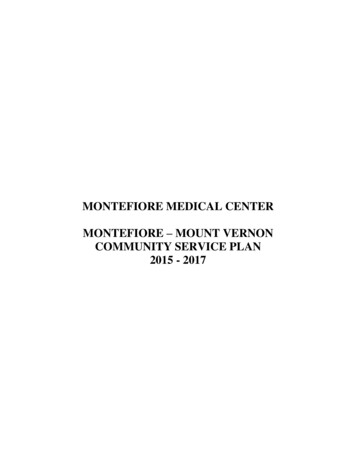
Transcription
MONTEFIORE MEDICAL CENTERMONTEFIORE – MOUNT VERNONCOMMUNITY SERVICE PLAN2015 - 2017
Montefiore Medical CenterMontefiore – Mount VernonCommunity Service Plan 2015-2017Table of ContentsPage1. Mission Statement12. Definition and Description of the Community ServedA) Description of Service AreaB) Population of Mount VernonC) Health Status of the City of Mount Vernon33553. Public Participation344. Assessment and Selection of Public Health Priorities365. Two Year Plan of Action - 2014-2017Prevent Chronic DiseasePromote Healthy Women, Infants and Children4041426. Dissemination of the Report to the Public457. Maintaining Engagement8. Financial Aid4647Appendix A: Data Sources DefinitionAppendix B: ReferencesAppendix C: Health Needs with Significance and Magnitude495159
1. Mission Statement: A Longstanding Commitment, A New FocusMontefiore Health System is a premier academic health system and the University Hospital forAlbert Einstein College of Medicine. Combining a nationally-recognized clinical excellence witha population health perspective that focuses on the health needs of communities, Montefioredelivers coordinated, compassionate, science-driven care where, when and how patients need itmost. Montefiore consists of six hospitals and an extended care facility with a total of 2,080 beds,a School of Nursing, and state-of-the-art primary and specialty care provided through a networkof more than 150 locations across the region, including the largest school health program in thenation and a home health program.Montefiore's partnership with Einstein advances clinical and translational research to acceleratethe pace at which new discoveries become the treatments and therapies that benefit patients. Themedical center derives its inspiration for excellence from its patients and community, andcontinues to be on the frontlines of developing innovative approaches to care.Montefiore’s Mission Statement and Strategy:In January 2009, Montefiore Medical Center completed a comprehensive review and update ofits strategic plan. The process included the development and approval by its Board of Trusteesof revised statements of the medical center’s Mission, Vision and Values.Mission:To Heal, To Teach. To Discover and to Advance the Health of the Communities We Serve.Vision:To be a premier academic medical center that transforms health and enriches lives.Values:Humanity, Innovation, Teamwork, Diversity and EquityAs part of that process, Montefiore established five Strategic Goals; setting out Montefiore’scourse for the decade to come:1. Advance our partnership with the Einstein College of Medicine2. Create notable Centers of Excellence3. Build specialty care broadly4. Develop a seamless delivery system with superior access, quality, safety and patientsatisfaction5. Maximize the impact of our community service1
The inclusion of an explicit statement affirming Community Service as part of Montefiore’sMission Statement is not new. It has always been one of the core elements of Montefiore’smission. What has changed is the explicit reference to “advancing the health of thecommunities we serve”, focusing on making a measurable difference in the health of thosepopulations and communities. This is further sharpened by the inclusion as one of the fivestrategic goals the imperative, to “maximize the impact of our community service.”In pursuing that goal, Montefiore has tasked itself:To better coordinate and focus its resources on specific high prevalence/high impactproblems affecting its community;To work internally and with community partners to identify priority health needs, and;To develop and implement more effective broad-based plans of action to address them,and to advance the health of the communities we serve.The rationale behind this change was the realization that we must focus our efforts, if we are tomake a real, measurable difference in the health of populations, and communities. That isessentially the same logic as underpins the state’s revised Community Service Plan process.Historically, Montefiore has earned a reputation as a leader in the region, state and nation inproviding services to its community, by developing and operating an extraordinary array ofneeded services to the poor and underserved, and to specific at-risk populations (eg. children, theelderly, the HIV-infected, the homeless and victims of domestic violence).Montefiore Mount Vernon Hospital (MVH), located 12 North Seventh Avenue, Mount Vernon,NY 10550 is a licensed 176-bed hospital comprised of 124 medical/surgical beds, 8 coronarycare beds, 12 intensive care beds, 22 Psychiatry beds and 10 AIDS beds. As a community-basedteaching hospital, MVH has been serving the medical needs of the community and region sinceits founding in 1891. As of November 6, 2013, as a part of the Montefiore Health System, apremier academic medical center and the University Hospital system for Albert Einstein Collegeof Medicine, Montefiore Mount Vernon Hospital continues to provide inpatient, critical care andambulatory services. Montefiore Mount Vernon Hospital is a New York State-designated StrokeCenter and HIV/AIDS Center, and it is home to the Beale Chronic Wound Treatment andHyperbaric Center and the Montefiore School of Nursing.2
2. Definition and Description of the Community Serviced: Hospital Service AreaA. Description of Service AreaMontefiore Mount Vernon Hospital has identified the city of Mount Vernon and its surroundingtowns and villages as its primary service area. Montefiore Mount Vernon Hospital is the onlyhospital in the City of Mount Vernon, which is the southernmost city in Westchester County.Adjacent to the Bronx, it is the most densely populated community in the County with more than70,000 citizens within its 4.4 square miles. MMVH also serves a portion of the Bronx populationthat is supported the Wakefield Campus of Montefiore Medical Center.The communities served by the MMVH are extremely diverse. The service area contains pocketsof prosperity, where health insurance coverage is more prominent, along with manyeconomically challenged neighborhoods whose residents are uninsured or underinsured. Most ofthe latter do not access healthcare routinely but rather present only in crisis through theEmergency Department.Mount Vernon is a diverse urban setting, with multiple sub-populations that evidencetremendous variation. In addition to Montefiore Mount Vernon Hospital, the community isserved by many independent providers including neighboring hospitals/systems, and a FederallyQualified Health Center, which has an overlapping service area. In this setting, the focus is onspecific health needs of specific populations, in targeted communities, working with specificpartners to address the needs of this community. The ability to apply services in a targetedfashion has been Montefiore’s historical approach to developing and operating its programs ofcommunity health, and that is the approach we have taken in developing this Community ServicePlan.3
Mount Vernon Service Area4
B. Population of Mount VernonAccording to the 2013 American Community Survey of the U.S. Census, Mount Vernon hasapproximately 68,000 residents within zip codes 10550, 10552, and 10553. This city is 4.4square miles; noted as the 8th largest city and 2nd most densely populated city in New York State.This city is located north of the Bronx and bordered by Pelham, Bronxville, Eastchester, andYonkers.There are approximately 26,000 households in Mount Vernon. The average household size is2.79 people. Families made up 65.6% of the households; includes both married-couple families(33.4%) and single householder families (32.2% total—3.8% male, 28.4% female). Nonfamilyhouseholds consist of 34.4% of all households in Mount Vernon; includes people living aloneand non-related people living under one household. 37.6% of households include one or morepeople under 18 years of age. 9.4% of households include one or more people 65 years of age orolder.Mount Vernon is ethnically diverse. Its population is 12.3% Hispanic, 64.7% African-American,24.7% White, 2.1% Asian, and 5.3% other. Almost one-third (34.2%) of its residents are foreignborn. Among these immigrants, more people speak only English at home than any otherlanguage. The city’s immigrant communities come from diverse corners of the globe (in order oftheir numbers): Jamaica, Brazil, Mexico, Dominican Republic, Portugal, the West Indies,Trinidad & Tobago, Italy, Barbados, & Guyana.The city has one of the highest percentages of residents living below the poverty line inWestchester County. The poverty rate is 17.1% (compared to 9.7% countywide) and the medianincome is 49,395 (compared to 84,220 countywide). 22.4% of Mount Vernon children areliving below poverty; higher than the countywide percentage of 13.3%.7.4% of Mount Vernon households are on public assistance, twice the percentages inWestchester County (2.8%) and New York State (3.5%). 70.8% of students in Mount Vernonwere eligible for reduced or free lunch during the 2010-2011 school year. The Mount Vernonunemployment rate of 11.7% is one of the highest unemployment rates in Westchester County.84.8% of Mount Vernon residents ages 25 and older have received their high school diploma orGED; lower than countywide (87.4%) and statewide (85.6%) attainment rates.C. Health Status of the City of Mount VernonThe health status of the city of Mount Vernon was measured across the indicators of overallhealth status as well as indicators of the social, environmental, and economic determinants ofhealth. The prevalence and/or incidence of both clinical and social determinants of health arereported from multiple sources, as detailed within the sections below. While there are areas ofimprovement, Mount Vernon’s rates remain significantly high, when compared to the remainderof Westchester County. When local municipality data is unavailable, County level data isprovidedThe residents in Mount Vernon have significantly high mortality rates from heart disease, cancer,stroke, and chronic lower respiratory diseases (CLRD).5
Mortality Rates:According to the New York State Department of Health’s (NYSDOH) Vital Statistics ofNew York State report in 2011, Westchester County (which includes the city of Mount Vernon)has an age-adjusted mortality rate of 713.4 per 100,000; similar to the statewide rate of 753.1.According to the Community Health Rankings in 2014, Westchester County ranked as number 3out of 62 NY counties to have the lowest mortality rate in New York State. The leading cause ofdeath among Westchester County residents is due to coronary heart disease (219.7 per 100,000).Asthma & CLRD:According to the NYSDOH, 8.7% of Westchester County adults had asthma from 20082009; lower than the statewide percentage of 9.7%.According to CDC data, the percentage of Westchester County adults with asthmaincreased to 14% from 2011-2012; same percentage as New York State.According to an asthma report from New York State Office of the State Comptroller, theasthma prevalence rate among Westchester County Medicaid recipients was 86.7 per 1,000 from2008-2009. The prevalence rate increased to 98.4 per 1,000 from 2012-2013; similar to thestatewide prevalence rate of 98.7.The average (age-adjusted) rate of asthma emergency department visits per 10,000 from2011 was 64.2 in Westchester County. In 2012, the rate of asthma emergency department visitsincreased to 67.4 per 10,000.In 2010, the age-adjusted death rate due to chronic lower respiratory diseases amongWestchester County residents was 24.3 per 100,000; lower than the statewide rate of 31.1. In2011, Westchester County ‘sdeath rate decreased to 23.4; remaining lower than the statewiderate of 31.2.Heart Disease & Stroke:The coronary heart disease mortality rate per 100,000 in Westchester County was 119.5in 2011; similar to the 2010 rate of 117.1. The coronary heart disease hospitalization rate per10,000 in Westchester County was 35.8 in 2011; similar to the 2010 rate of 36.4.The cerebrovascular disease (stroke) mortality rate per 100,000 in Westchester Countywas 25.8 in 2011; an increase from the 2010 rate of 24.0. The stroke hospitalization rate per10,000 in Westchester County from 2009-2011 was 22.8; similar to the statewide rate of 24.9.The cardiovascular disease mortality rate per 100,000 in Westchester County was 199.2in 2011; an increase from the 2010 rate of 195.5. The cardiovascular disease hospitalization rateper 10,000 in Westchester County was 133.1; similar to the 2010 rate of 135.9.Cancer:The mortality rate of all cancer diagnoses in Westchester County was 150.5 in 2010;similar to the statewide rate of 160.2. The type of cancer with the highest mortality rate inWestchester County is lung cancer (36.9 per 100,000; lower than the statewide rate of 41.8).6
The incidence rate of all cancer diagnoses in Westchester County was 495.2 per 100,000in 2010; similar to the statewide rate of 482.5. The type of cancer with the highest incidence ratein Westchester County is prostate cancer (22.6 per 100,000; similar to the statewide rate of 21.3).Health Status of the City of Mount Vernon: Health Indicators & Data Sources1. Access to Quality Health ServicesAccording to the U.S. Census Bureau, 75.6% of adults (see Figure 1a) and 95.2% ofchildren in Mount Vernon had health insurance in 2012. The percentage of MountVernon adults with health insurance in 2012 was lower than the Westchester Countyand New York State (NYS) adult percentages (see Figure 1b). The percentage amongchildren in Mount Vernon in 2012 was lower than the Westchester County andstatewide percentages (see Figure 1c).In 2013, the percentage of Mount Vernon residents with health insurance increased to82.7% for adults (see Figure 1a) and 94.5% for children. The percentage of MountVernon adults with health insurance in 2013 remained lower than the WestchesterCounty and NYS percentages (see Figure 1b). The percentage among Mount Vernonchildren in 2013 decreased lower than the countywide and statewide percentages (seeFigure 1c).From 2012-2013, Mount Vernon children were more likely to have health insurancecoverage than Mount Vernon adults. In 2012, the percentage of Mount Vernonchildren with health insurance was lower than the overall percentages among childrenin Westchester County and New York State. Despite the decrease in 2013, thepercentage of Mount Vernon children remained higher than that of Mount Vernonadults. The percentage of Mount Vernon adults with health insurance increased overthe years; however, the Mount Vernon percentage remained lower than thecountywide and statewide percentages.Figure 1a. Residents with Health Insurance: Mount Vernon 2012-201395.2%Percentage with hildren20%0%20122013Year of DataSource: U.S. Census Bureau (American Community Survey, 2012 & 2013)7
Figure 1b. Percentage of Adults with Health Insurance:Mount Vernon, Westchester County, & New York State 2012-2013Year of Data75.6%201283.3%84.6%Mount Vernon82.4%2013Westchester County85.1%New York State85.0%0%20%40%60%80%100%Percentage with Health InsuranceSource: U.S. Census Bureau (American Community Survey, 2012 & 2013)Figure 1c. Percentage of Children with Health Insurance:Mount Vernon, Westchester County, & New York State 2012-2013Year of Data95.2%201297.0%96.1%94.5%201396.9%Mount VernonWestchesterCountyNew York State96.0%0%20%40%60%80%Percentage with Health Insurance100%Source: U.S. Census Bureau (American Community Survey, 2012 & 2013)8
Preventable Hospital Stays: Top 20 Inpatient DiagnosesFigure 1d illustrates 20 ailments with the highest total number of patient diagnoses throughoutMount Vernon (zipcodes: 10550; 10551; 10552; & 10553) from 2011-2013. The total number ofpatients diagnosed with each of the top 20 ailments represents hospital discharges among allMount Vernon residents. These ailments were categorized using the DRG coding system.From 2011-2013, Psychoses had the highest total number of inpatient diagnoses in MountVernon.Among the top 20 inpatient diagnoses, Diabetes without Complications & ComorbidConditions, or Major Complications & Comorbid Conditions had the lowest total numberof inpatient diagnoses in Mount Vernon from 2011-2013.The following diagnoses have decreased over the 2011-2013 period in the following areacodes:o Alcohol/Drug Abuse or Dependence without Rehabilitation Therapy, withoutMajor Complications & Comorbid Conditionso Diabetes without Complications & Comorbid Conditions, or Major Complications& Comorbid Conditionso Bronchitis & Asthma without Complications & Comorbid Conditions, or MajorComplications & Comorbid Conditionso Septicemia or Severe Sepsis without Mechanical Ventilation 96 Hours withMajor Complication or ComorbidityThe following diagnoses have increased over the 2011-2013 period:o Neonate/Newborns with Other Significant Problemso Cellulitis without Major Complications & Comorbid Conditionso Heart Failure & Shock with Complications & Comorbid ConditionsThe following inpatient diagnoses increased in 2012 and decreased in 2013:o Psychoseso Vaginal Delivery without Complicating Diagnoseso Chest Paino Esophagitis, Gastroenteritis & Miscellaneous Digestive Disorders without MajorComplication or Comorbidityo Red Blood Cell Disorders without Major Complication or Comorbidity9
o Cesarean Section with Complications & Comorbid Conditions, or MajorComplications & Comorbid Conditionso Syncope & Collapseo Miscellaneous Disorders of Nutrition, Metabolism, & Fluid/Electrolytes withoutMajor Complication or Comorbidityo Seizures without Major Complications & Comorbid ConditionsThe following inpatient diagnoses decreased in 2012 and increased in 2013:o Cesarean Section without Complications & Comorbid Conditions, or MajorComplications & Comorbid Conditionso Simple Pneumonia & Pleurisy with Complications & Comorbid Conditionso Kidney & Urinary Tract Infections without Major Complications & ComorbidConditionsThere was no significant change in the number of inpatient diagnoses for Major JointReplacement or Reattachment of Lower Extremity without Major Complications &Comorbid Conditions from 2011-2012. The number of inpatient diagnoses for thiscondition decreased in 2013.The major health indicator themes that are described among the top 20 inpatient diagnosesin Mount Vernon are:o Mental Diseases & Disorderso Maternal, Fetal, & Infant Healtho Substance Abuseo Diseases & Disorders of the Digestive Systemo Respiratory Disorderso Circulatory System Disorders10
Figure 1d. Top 20 discharges: Mount Vernon, NYSource: SPARCSDRGDescriptionMSDRG-885PsychosesVaginal Delivery W/O ComplicatingMSDRG-775DiagnosesAlcohol/Drug Abuse Or Dependence W/OMSDRG-897Rehabilitation Therapy W/O MccMSDRG-313Chest PainEsophagitis, Gastroent & Misc DigestMSDRG-392Disorders W/O MccMSDRG-766Cesarean Section W/O Cc/MccMSDRG-812Red Blood Cell Disorders W/O MccMSDRG-794Neonate W Other Significant ProblemsMSDRG-603Cellulitis W/O MccMSDRG-765Cesarean Section W Cc/MccMSDRG-312Syncope & CollapseMSDRG-203Bronchitis & Asthma W/O Cc/MccSepticemia Or Severe Sepsis W/O Mv 96 MSDRG-871Hours W MccMSDRG-194Simple Pneumonia & Pleurisy W CcMisc Disorders 1W/O MccMSDRG-101Seizures W/O MccMSDRG-292Heart Failure & Shock W CcMSDRG-690Kidney & Urinary Tract Infections W/O MccMajor Joint Replacement Or ReattachmentMSDRG-470Of Lower Extremity W/O MccMSDRG-639Diabetes W/O 1281928699649593115581155611143Preventable Hospital Stays: Top 20 Inpatient Ambulatory Sensitive DischargesFigure 1e illustrates 20 ailments with the highest total number of inpatient ambulatory sensitivedischarges throughout Mount Vernon from 2011-2013. The total number of patients diagnosedwith each of the top 20 ailments represents sensitive ambulatory discharges among all MountVernon residents. The top 20 ailments were categorized using the DRG coding system.From 2011-2013, Chest Pain had the highest total number of inpatient ambulatorysensitive discharges in Mount Vernon.Among the top 20 inpatient ambulatory sensitive discharges, Chronic ObstructivePulmonary Disease with Major Complications & Comorbid Conditions had the lowesttotal number of inpatient diagnoses in Mount Vernon from 2011-2013.The following ambulatory sensitive discharges have decreased over the 2011-2013period:o Diabetes without Complications & Comorbid Conditions, or Major Complications& Comorbid Conditions11
The following ambulatory sensitive discharges have increased over the 2011-2013period:o Cellulitis without Major Complications & Comorbid ConditionsThe following ambulatory sensitive discharges increased in 2012 and decreased in 2013:o Chest Paino Esophagitis, Gastroenteritis & Miscellaneous Digestive Disorders without MajorComplications & Comorbid Conditionso Syncope & Collapseo Bronchitis & Asthma without Complications & Comorbid Conditions, or MajorComplications & Comorbid Conditionso Miscellaneous Disorders of Nutrition, Metabolism, & Fluids/Electrolytes withoutMajor Complications & Comorbid Conditionso Seizures without Major Complications & Comorbid Conditionso Heart Failure & Shock without complications & comorbid conditionso Diabetes with Complications & Comorbid Conditionso Simple Pneumonia & Pleurisy without Complications & Comorbid Conditions, orMajor Complications & Comorbid Conditionso Cardiac Arrhythmia & Conduction Disorders without Complications & ComorbidConditions, or Major Complications & Comorbid Conditionso Heart Failure & Shock without Complications & Comorbid Conditions, or MajorComplications & Comorbid Conditionso Chronic Obstructive Pulmonary Disease with Major Complications & ComorbidConditionsThe following ambulatory sensitive discharges decreased in 2012 and increased in 2013:o Simple Pneumonia & Pleurisy with Complications & Comorbid Conditionso Kidney & Urinary Tract Infections without major complications & comorbidconditionso Bronchitis & asthma with Complications & Comorbid Conditions, or MajorComplications & Comorbid Conditionso Chronic Obstructive Pulmonary Disease with Complications & ComorbidConditions12
There was an increase in the number of ambulatory sensitive discharges for ChronicObstructive Pulmonary Disease without Complications & Comorbid Conditions, or MajorComplications & Comorbid Conditions from 2011-2012. There was no significant changein the number of discharges in 2013.There was a decrease in the number of ambulatory sensitive discharges for Heart Failure& Shock with Major Complications & Comorbid Conditions from 2011-2012. There wasno significant change in the number of discharges in 2013.The major health indicator themes that are described among the top 20 ambulatorysensitive discharges in Mount Vernon are:o Diseases & Disorders of the Digestive Systemo Respiratory Disorderso Nutrition Disorderso Circulatory System Disorderso Heart Diseaseso DiabetesFigure 1e. Top 20 ambulatory sensitive discharges: Mount Vernon, NYSource: SPARCSDRG codeDescriptionMSDRG-313Chest PainEsophagitis, Gastroent & Misc DigestMSDRG-392Disorders W/O MccMSDRG-603Cellulitis W/O MccMSDRG-312Syncope & CollapseMSDRG-203Bronchitis & Asthma W/O Cc/MccMSDRG-194Simple Pneumonia & Pleurisy W CcMisc Disorders 1W/O MccMSDRG-101Seizures W/O MccMSDRG-292Heart Failure & Shock W CcMSDRG-690Kidney & Urinary Tract Infections W/O MccMSDRG-639Diabetes W/O Cc/MccMSDRG-638Diabetes W CcMSDRG-195Simple Pneumonia & Pleurisy W/O Cc/MccMSDRG-202Bronchitis & Asthma W Cc/MccChronic Obstructive Pulmonary DiseaseMSDRG-192W/O Cc/MccMSDRG-291Heart Failure & Shock W MccCardiac Arrhythmia & Conduction DisordersMSDRG-310W/O Cc/MccMSDRG-293Heart Failure & Shock W/O Cc/MccChronic Obstructive Pulmonary Disease WMSDRG-191CcChronic Obstructive Pulmonary Disease 84750615255596747Preventable Hospital Stays: Top 20 ED Diagnoses13
Figure 1f illustrate 20 ailments with the highest total number of patient diagnoses in theemergency departments of Mount Vernon hospitals from 2011-2013. The total number ofpatients diagnosed with each of the top 20 ailments represents ED diagnoses among all MountVernon residents. These ailments were categorized using the ICD-9 coding system.From 2011-2013, Asthma (unspecified type) with Exacerbation had the highest totalnumber of ED diagnoses in Mount Vernon.Among the top 20 ED diagnoses, Rash & Other Nonspecific Skin Eruptions had thelowest total number of ED diagnoses in Mount Vernon from 2011-2013.The following ED discharges have decreased over the 2011-2013 period:o Asthma (unspecified type) with Exacerbationo Acute Upper Respiratory Infections of Unspecified Siteo Headacheo Otitis Media (unspecified)o Abdominal pain (other site)o Neck Spraino Rash & Other Nonspecific Skin Eruptionso Ankle Sprain (unspecified type)The following ED discharges have increased over the 2011-2013 period:o Viral Infection (unspecified type)The following ED discharges increased in 2012 and decreased in 2013:o Other & Unspecified Noninfectious Gastroenteritis & Colitiso Urinary Tract Infection (unspecified site)o Head Injury (unspecified type)o Chest Pain (unspecified type)o Acute Bronchitiso Abdominal Pain (unspecified site)The following ED discharges decreased in 2012 and increased in 2013:o Chest Pain (other)14
o Acute Pharyngitiso Lumbagoo Fever (unspecified type)o Dizziness & GiddinessThe major health indicator themes that are described among the top 20 ED discharges inMount Vernon are:o Respiratory Disorderso Diseases & Disorders of the Digestive Systemo Chronic Pain Disorderso Infectious Diseaseso Skin DisordersFigure 1f. Top 20 ED diagnoses: Mount Vernon, NYSource: SPARCSICD-9 diagnosis code Description49392Asthma NOS W Exacer4659Acute URI NOS78659Chest Pain NEC7840Headache5589NonINF Gastroent NEC&NOS3829Otitis Media NOS462Acute Pharyngitis7242Lumbago78909Abdominal Pain-Site NEC7999Viral Infection NOS5990Urinary Tract INF NOS78060Fever NOS95901Head Injury NOS78650Chest Pain NOS4660Acute Bronchitis7804Dizziness & Giddiness8470Neck Sprain7821Nonsp Skin Eruption NEC78900Abdominal Pain-Site NOS84500Ankle Sprain 39143738535546040824138129521431028314029226815
2. Chronic DiseasesChronic Diseases: CancerBreast Cancer (citywide data unavailable):According to the Centers for Disease Control & Prevention (CDC) and the New YorkState Department of Health (NYSDOH), the female breast cancer incidence rate inWestchester County was 141.5 per 100,000 females in 2009 (see Figure 2a). TheWestchester County rate was higher than the statewide rate of 130.7 (see Figure 2b).In 2010, Westchester County’s female breast cancer incidence rate decreased to 137.2;remaining higher than the statewide rate of 127.60 (see Figure 2b).The age-adjusted death rate due to breast cancer in Westchester County was 23.0 per100,000 females in 2009. The death rate decreased to 17.4 per 100,000 females in2010 (see Figure 2a). The Westchester County rate was lower than the statewide rateof 21.3 (see Figure 2b).Rate per 100,000 W.C. FemalesOverall, Westchester County’s female breast cancer incidence and death rates havedecreased in the last few years. The breast cancer death rate in Westchester Countywas lower than the statewide rate in 2010; however, the breast cancer incidence rateamong Westchester County females remained higher than the statewide incidence rate.Figure 2a. Female Breast CancerIncidence & Death Rates: Westchester County, 2009-2010.160140120100806040200141.5137.2Incidence RateAge-adjusted Death Rate23.017.420092010Year of DataSource: NYSDOH (Female Breast Cancer Incidence Rate per 100,000;Female Breast Cancer Mortality Rate per 100,000)16
Figure 2b. Female Breast Cancer Incidence & Death Rates:Westchester County & New York State, 2010.Rate per 100,000Females140137.2127.6120100Incidence Rate80Age-adjusted Death Rate60402017.421.30Westchester CountyNew York StateSource: NYSDOH (Female Breast Cancer Incidence Rate per 100,000;Female Breast Cancer Mortality Rate per100,000)According to the County Health Rankings data, 67.6% of Westchester County femaleMedicare enrollees ages 67-69 reported in 2010 that they received at least onemammography screening over a two-year period; higher than the statewide percentageof 65.9%. In 2011, 66% received at least one mammography screening; remaininghigher than the statewide percentage of 63%.Colorectal Cancer (citywide data unavailable):According to the NYSDOH, the colorectal cancer incidence rate among WestchesterCounty residents in 2009 was 36.8 per 100,000 persons; lower than the statewide rateof 44.3. In 2010, the incidence rate among Westchester County residents was 42.0; nosignificant difference from the statewide rate of 42.9 (see Figure 2c).The age-adjusted death rate due to colorectal cancer was 13.8 per 100,000 amongWestchester County residents in 2009; lower than the statewide rate of 15.4. In 2010,the death rate among Westchester County residents was 13.3; remaining lower than thestatewide rate of 14.9 (see Figure 2c).Overall, the colorectal cancer incidence rate among Westchester County residentsincreased over the years. Although the colorectal death rate among WestchesterCounty residents remained lower than the statewide rate, there was no significantchange in the Westchester County rate from 2009-2010.In 2012, 72.3% of Westchester County residents ages 50 and older had a colonoscopyin the past 10 years; higher than the statewide percentage of 65.2%.17
Rate per 100,00 PersonsF
NY 10550 is a licensed 176-bed hospital comprised of 124 medical/surgical beds, 8 coronary . Adjacent to the Bronx, it is the most densely populated community in the County with more than . GED; lower than countywide (87.4%) and statewide (85.6%) attainment rates. C. Health Status of the City of Mount Vernon
